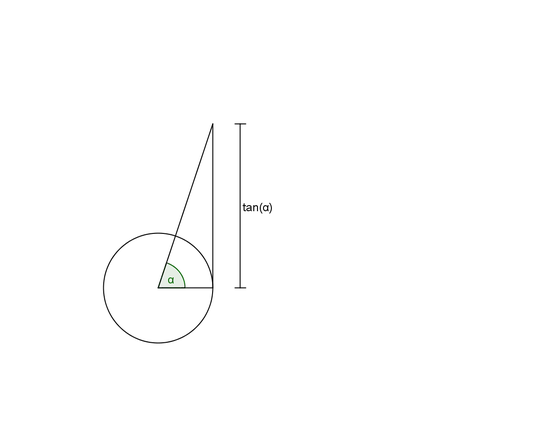Why is the trigonometric function $\tan((1/2)\pi)$ undefined?
-
3What is the definition of $\tan$ ? – Ulrik Jan 09 '14 at 20:19
-
1If it were defined - what would it be? – Mark Bennet Jan 09 '14 at 20:27
-
http://math.stackexchange.com/questions/189621/is-tan-pi-2-undefined-or-infinity – lab bhattacharjee Jan 10 '14 at 05:42
5 Answers
The identity that relates $\color{blue}{\tan}$ with $\color{red}{\sin}$ and $\color{green}{\cos}$ is: $$\color{blue}{\tan}(\alpha)=\frac{\color{red}{\sin}(\alpha)}{\color{green}{\cos}(\alpha)}\tag{1}$$
and $\color{green}{\cos}\color{black}{(}\pi/2\color{black})=0$, adding to it the fact that division by zero is undefined, it follows that $\color{blue}{\tan}(\pi/2)$ is undefined.
Furthermore, since $\color{green}{\cos}\left(n\pi-\pi/2\right)=0$ for every $n\in\Bbb Z$ , we conclude from $\text{(1)}$ that for every $n\in\Bbb Z$, $\color{blue}{\tan}(n\pi-\pi/2)$ is undefined.
Here's an answer that is not really about division by $0$. $\tan(\alpha)$ is the length of the line segment that is tangent to the unit circle in the image below. So what would happen to this length if $\alpha$ were $\pi/2$?

Note this diagram works for all nonvertical angles as long as you interpret the "length" of the tangent segment as negative if it ends up on the lower side, and also as long as you are willing to pull back rays from obtuse angles until they intersect that vertical line there.
It's debatable that $\tan(x)$ is defined as $\frac{\sin(x)}{\cos(x)}$, as some other answers suggest. I think its name suggests that its original definition is more like what we see in this diagram: something about a tangent line. It just happens to be equal to $\frac{\sin(x)}{\cos(x)}$ because of similar triangle ratios. Similarly, $\sec(x)$ is the length of the hypotenuse in this picture, and a secant line is any line that cuts through a curve, like the hypotenuse here cuts through the circle.
- 54,717
Because $\tan(x)$ is defined as being equal to $\sin(x)/\cos(x)$, and $\cos(\pi/2)=0$. So $\tan(\pi/2)=1/0$, which is undefined because of the division by zero.
- 21
Well, you can see that $$\tan x:= \frac{\sin x}{\cos x}$$ and it's known that $\sin \frac{\pi}{2}=1$ and $\cos \frac{\pi}{2}=0$.
- 1,698
A feature not explained in other answers is that you can't define the tan function as simply "infinite" at the point of discontinuity. From one side it is unboundedly positive, and from the other unboundedly negative.
- 100,194